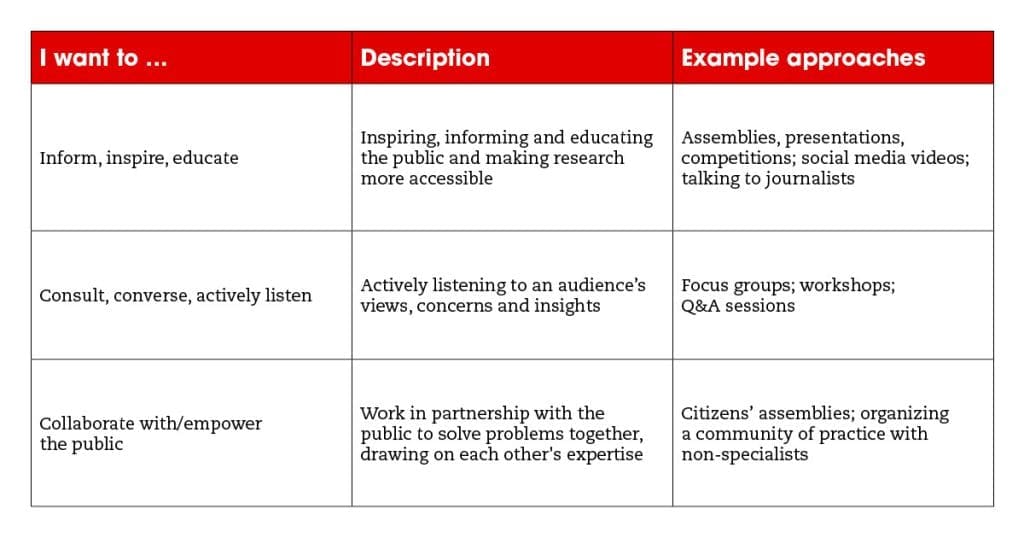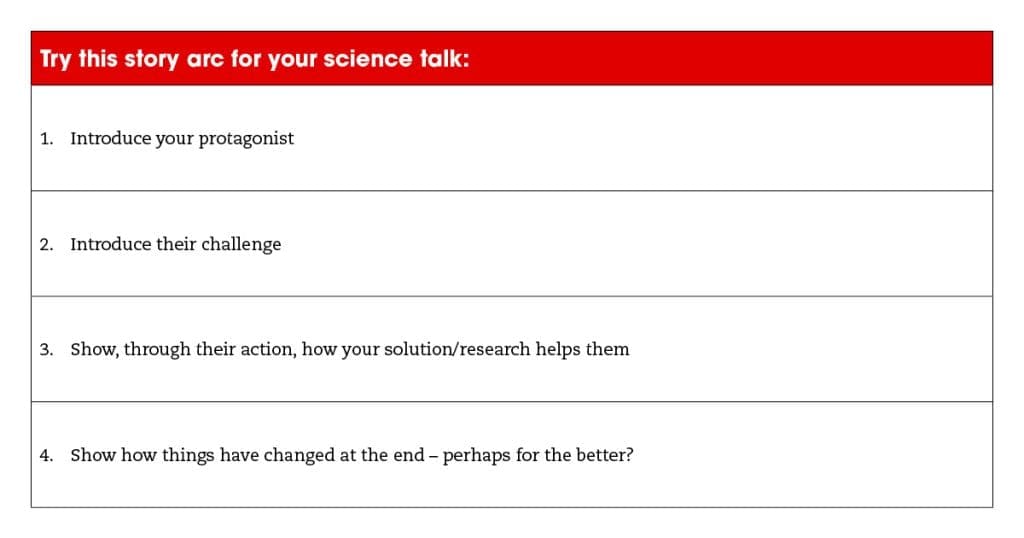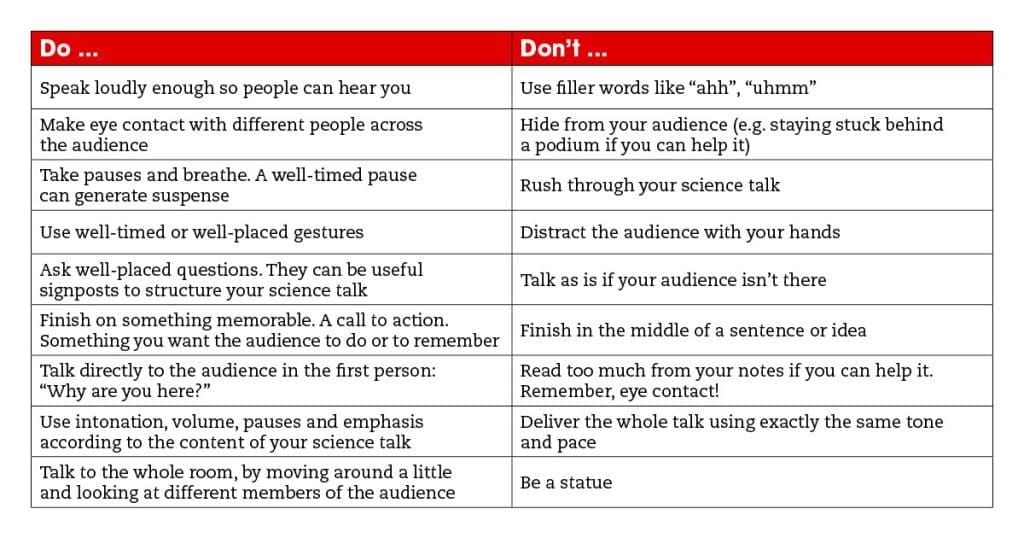
Image: ©henri mathieusaint laurent
18/11/22
Script Practical Guide
How to give a good science talk anywhere
Speed read
- A talk may take different forms depending on its purpose
- Have a strong idea and deliver it effectively
- Make science reach the hearts and minds of your audience
By: Juan Casasbuenas
Why should I give a science talk?
A good science talk is fit for purpose
Have a strong message
Connect with your audience
Tell a story
Keep it simple and relatable
Make it authentic
Dos and don’ts
Perfecting your talk
Why should I give a science talk?
There are many good reasons to give a science talk.
You’ll be able to talk to people from other disciplines about your work, improving the chances of collaboration. Besides, a good science talk can drum up support for your research. It might even get you more funding. Moreover, an inspired young audience might decide to take up scientific research as a result of what you have to say.
Therefore, the potential benefits of giving a science talk are far-reaching and should not be underestimated. A clear, persuasive message about your work can help you talk to journalists (and therefore help you reach more people). This in turn can contribute to informed decision making at different levels of society. If more people get involved in science, it can become more diverse and inclusive.
Ultimately, you have to ask yourself: why do you want to talk to the public about science?
Is it to inform better decision making? Is it to consult? Or perhaps you want to involve members of the public in your work somehow?
This practical guide talks you through the main qualities of a good science talk. As we will now see, this can take different forms depending on what you are trying to achieve.
A good science talk is fit for purpose
When we think of a “talk”, our mind might jump straight to the “short presentation” format, whether that’s a science TED talk, a Famelab presentation, a Three-Minute Thesis, or a Falling Walls presentation. There are, however, many other ways to talk about science. For example, you might give a guided tour of your lab, hold a Q&A session about your work, or deliver a hands-on workshop.
If your aim is to influence and inform a very large audience, you need to be able to talk to journalists. Another way might be through social media, which might include short videos of yourself talking about a key issue.
Perhaps you are more interested in more sustained, hands-on public engagement work. You want to raise awareness about a particular disease in a rural community but you need the views of the public to do so effectively. Accordingly, you’ve decided to work closely with members of a community (young people, taxi drivers, shop owners, community leaders) to co-design effective awareness-raising interventions.

Regardless of the level of engagement or impact you want to achieve (see the summary table above), all of these approaches require you to be good at talking about your work. The rest of the practical guide focuses on how to do this.
It all starts with a strong message.
Have a strong message
At the heart of a good science talk is a strong message. A big idea. If there is one thing you want your audience to leave the room with, that’s it. It’s usually an answer to a “why” question … and you really need to have a “so what” response.
- Why should I care about sequencing the potato genome? … So we can feed more people and combat disease more effectively
- Why should we pay more attention to vaccine supply chains and conflict in emergencies? … So more people get vaccinated
- Why should I care about sea temperature and shoal behaviour in fish? … So that we know where the next catch of the day will come from
Your “so what” needs to be something your audience can relate to. They can immediately see why it might matter to them. The only way of crafting this effectively is by knowing your audience well. It’s a combination of having a strong idea and of delivering it in a way that really resonates with your audience.
Let’s explore how we might do that.
Connect with your audience
Before crafting your science talk, you should be asking yourself a number of questions about your audience, for example:
- What are their hopes and aspirations?
- What are the challenges they face day to day?
- What keeps them up at night?
- Is there something they need they aren’t getting?
- What do they find funny or interesting?
- What are they currently reading or watching?
… and how does (my) science relate to these questions?
A good science talk should feel real and relevant. It should speak to the lives of the people listening to you. This rich detail will bring your science talk to life. Ideally, you can find out the answers to the above questions by talking to your audience in the first place.
For instance, why should your audience care about AI and the quest for new antivirals? Perhaps it means avoiding bankruptcy while keeping the family safe.
Accordingly, your science talk needs to feel tangible, relatable and most of all relevant to the audience. This often comes in the form of anecdotes and stories (see the next section!) rooted in the local context of your audience.
A good science talk doesn’t always have to reference the everyday. The key is to have one or two angles or hooks that resonate with the audience. Therefore, you might choose to relate your talk to current affairs; refer to a popular TV show or cultural reference; highlight an issue that you know is in the hearts and minds of the audience; or use a crazy statistic to make them sit up and pay attention.
Once you have chosen an approach, it is fundamental to deliver it in a way that makes sense. Often the best way to deliver a good science talk is through the art of storytelling.
Tell a story
There are several advantages to structuring your science talk as a story.
Stories allow you to show an audience how something affects a protagonist. Through a story, you can show people how a particular scientific breakthrough or issue affects someone’s life.
Through the actions of a protagonist, it will be easy for a member of the audience to imagine how something might affect them. A story will evoke emotion, and therefore a stronger connection with what you have to say.
Audiences respond to villains and heroes. You can frame your science talk in this way. What is the “villain” or problem you are trying to overcome through your work? Is it a drought? A particular outbreak? Deforestation?
… and how will the hero overcome the sense of threat or struggle that you’ve depicted? The hero can be your research. Alternatively, it can be a character or a real person who shows the audience how a struggle can be overcome. Whoever or whatever it is, the idea is to take the audience through a journey – from darkness to light. From despair to hope. From failure to triumph.
There are different “shapes” to the storytelling journeys you can experiment with. Most stories set the scene, then something disrupts the “balance” of everyday life (a villain!) … and through the actions of the main characters, adversity is overcome.

Whatever approach you take, don’t overcomplicate it.
Keep it simple and relatable
A good science talk is easy to follow. This starts with the language you use. For example, think “best” instead of “optimum”. Likewise, say “wrong” instead of “erroneous”; “part” instead of “proportion”; “buy” instead of “purchase”. The priority is to deliver your big message, not for the audience to get bogged down with jargon that detracts from the story you want to tell.
Putting things into context or relatable terms will help with this, too. Translate big or tricky numbers into terms that are relatable. For example, if something weighs 3800 kg, say it’s about as heavy as an adult hippopotamus. Something might be “about twice the area of Nairobi” (1400 square kilometres), or have the thickness of a human hair (70 microns). A carefully chosen number or statistic can wow your audience, but don’t overdo it.
It’s all too common to equate simplification with dumbing down. Think of it as removing unnecessary noise so that your big message comes through loud and clear. A strong delivery of your science talk can help with that.
Make it authentic
You might be advised to “be yourself” when delivering a science talk. What does this mean in practice?
Deliver your science talk in a way that feels natural to you. If you’re not usually a stand-up comedian, don’t try to be one. If an emotional delivery doesn’t come naturally to you, don’t try to be overly animated. Lean in to your strengths as a speaker, whether that’s the pace at which you speak or your natural tone of voice. An audience can tell when you’re not being your authentic self.
Dos and don’ts
You should try to get rid of habits that distract from your message. Get rid of the noise. Here are a few dos and don’ts that are easy wins for a good science talk.

Perfecting your talk
There’s only one way of developing the good habits in the list above: through practice. Rehearse your talk with families and friends and be prepared to take on feedback. You can also join public speaking groups like Toastmasters or even start your own!
You also need to practise your science communication skills. Check out our free online courses in science communication to further hone many of the skills covered in this practical guide.
You might also like
- How to brief policymakers on science issues
- How to start a science blog
- How to give a good science talk anywhere
- How to give a science flash talk
Other useful links
- Plain English Campaign’s A–Z of alternative words
- The Measure of Things: A search engine for comparative measurements
- A Manifesto for the Simple Scribe: Twenty-five commandments from science editor Tim Radford

